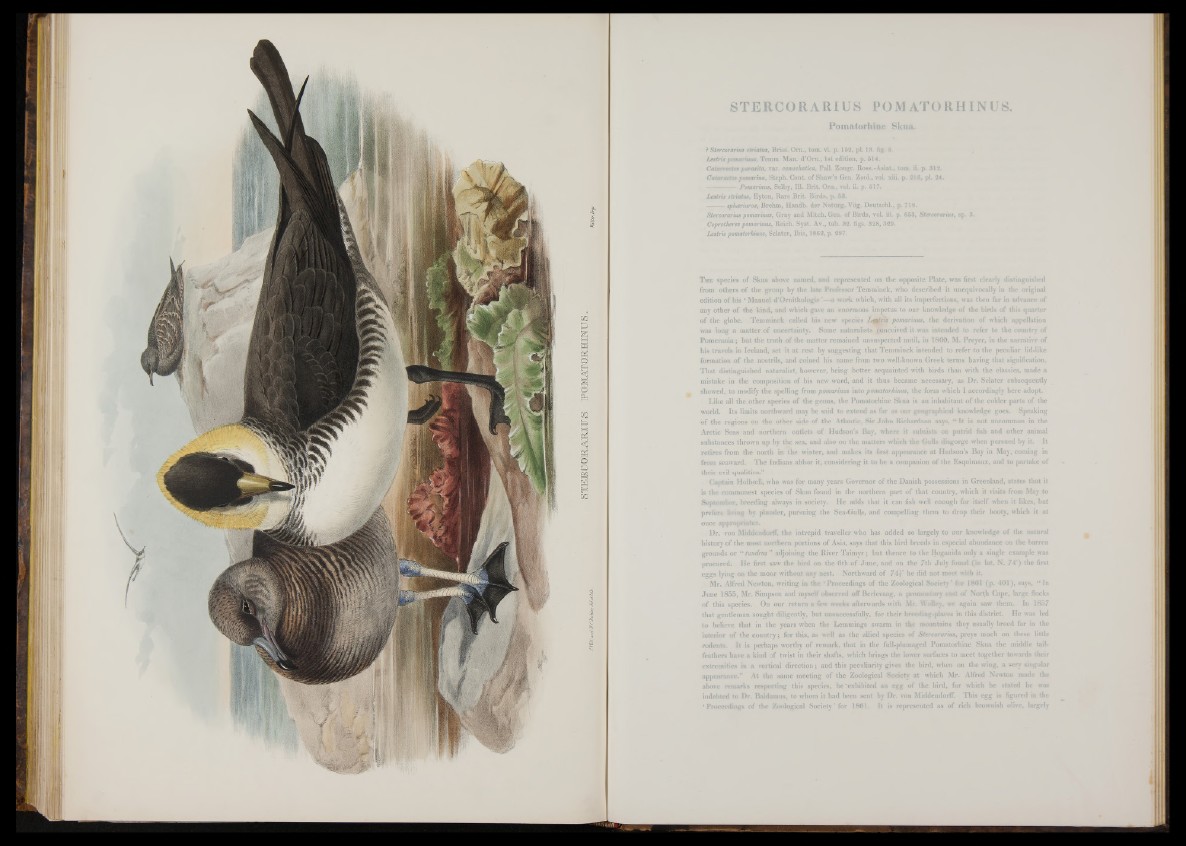
Pomatorhine Skua.
? Stercorarius striatus, Briss. Om., tom. vi. p. 152, pi. 13. fig. 2.
Lestris pomaritnu, Temm. Man. d’Om., 1st edition, p. 514.
Catarractes partuita, var. camschatica, Pall. Zoogr. Ross.-Asiat., tom. ii. p. 312.
Caiaractes pomerina, Steph. Cont. of Shaw’s Gen. Zool., vol. xiii. p. 216, pi. 24.
------------- Pomartnus, Selby, 111. Brit. Om., vol. ii. p. 617.
Lestris striatus, Eyton, Rare Brit. Birds, p. 53.
sphariuros, Brehm, Handb. der Natorg. Vog. Deutschl., p. 718.
Stercorarius pomartnus, Gray and Mitch. Gen. of Birds, vol. iii. p. 653, Stercorarius, sp. 3.
Coprotheres pomartnus, Reich. Syst. Av., tab. 32. figs. 328, 329.
■Lestris pomatorhmus, Sclater, Ibis, 1862, p. 297.
The species of Skua above named, and represented on the opposite Plate, was first clearly distinguished
from others o f the group by the late Professor Temminck, who described it unequivocally in the original
edition o f his 1 Manuel d’Ornithologie '—a work which, with all its imperfections, was then far in advance of
any other o f the kind, and which gave an enormous impetus to our knowledge o f the birds o f this quarter
of the globe. Temminck called his new species Lestris pomartnus, the derivation o f which appellation
was long a matter of uncertainty. Some naturalists conceived it was intended to refer to the country of
Pomerania ; but the truth of the matter remained unsuspected until, in 1860, M. Preyer, in the narrative of
his travels in Iceland, set it at rest by suggesting that Temminck intended to refer to the peculiar lid-like
formation o f the nostrils, and coined his name from two well-known Greek terms having that signification.
That distinguished naturalist, however, being better acquainted with birds than with the classics, made a
mistake in the composition o f his new word, and it thus became necessary, as Dr. Sclater subsequently
showed, to modify the spelling from pomartnus into pomatorhmus, the form which 1 accordingly here adopt.
Like all the other species o f the genus, the Pomatorhine Skua is an inhabitant o f the colder parts of. the
world. Its limits northward may be said to extend as far as our geographical knowledge goes. Speaking
o f the regions on the other side o f the Atlantic, Sir John Richardson says, “ It is not uncommon in the
Arctic Seas and northern outlets of Hudson’s Bay, where it subsists on putrid fish and other animal
substances thrown up by the sea, and also on the matters which the Gulls disgorge when pursued by it. It
retires from thé north in the winter, and makes its first appearance at Hudson’s Bay in May, coming in
from seaward. The Indians abhor it, considering it to be a companion o f the Esquimaux, and to partake of
their evil qualities.”
Captain Holboell, who was for many years Governor o f the Danish possessions in Greenland, states that it
is the commonest species o f Skua found in the northern part o f that country, which it visits from May to
September, breeding always in society. He adds that it can fish well enough for itself when it likes, but
prefers bving by plunder, pursuing the Sea-Gulls, and compelling them to drop their booty, which it at
once appropriates.
Dr. von Middendorff, the intrepid traveller who has added so largely to our knowledge o f the natural
history o f the most northern portions o f Asia, says that this bird breeds in especial abundance on the barren
grounds or “ tundras ” adjoining the River Taimyr ; but thence to the Boganida only a single example was
procured. He first saw the bird on the 6 th o f June, and on the 7th July found (in lat, N. 74 ) the first
eggs lying on the moor without any nest. Northward o f 74-§-° he did not meet with it.
Mr. Alfred Newton, writing in the ‘ Proceedings o f the Zoological Society’ for 1861 (p. 401), says, “ In
June 1855, Mr. Simpson and myself observed off Berlevaag, a promontory east o f North Cape, large flocks
o f this species. On our . return a few weeks afterwards with Mr. Wolley, we again saw them. In 1857
that gentleman sought diligently, but unsuccessfully, for their breeding-places in this district. He was led
to believe that in the years when the Lemmings swarm in the mountains they usually breed far in the
interior of the country ; for this, as well as the allied species o f Stercorarius, preys much on these little
rodents. It is perhaps worthy o f remark, that in the full-plumaged Pomatorhine Skua the middle tail-
feathers have a kind o f twist in their shafts, which brings the lower surfaces to meet together towards their
extremities in a vertical direction ; and this peculiarity gives the bird, when on the wing, a very singular
appearance.” At the same meeting o f the Zoological Society at which Mr. Alfred Newton made the
above remarks respecting this species, he'exhibited an egg o f the bird, for which he stated he was
indebted to Dr. Baldamus, to whom it had been sent by Dr. von Middendorflf. This egg hi figured in the
‘ Proceedings o f the Zoological Society’ for 1861. It is represented as o f rich brownish olive, largely